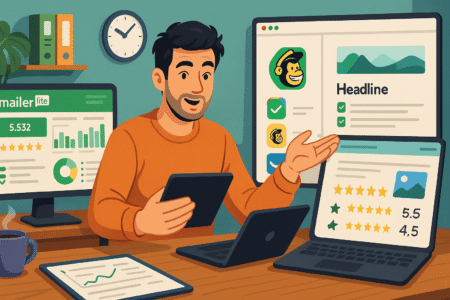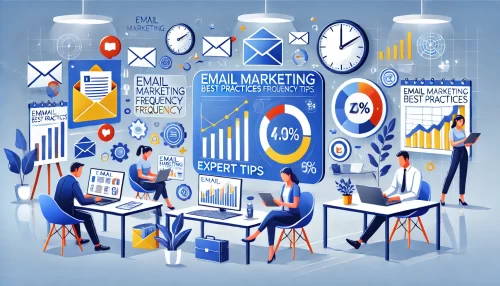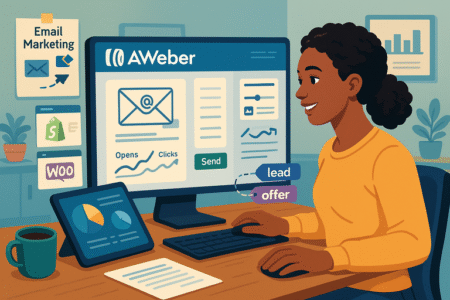Table of Contents
Are you struggling to figure out how to run an email marketing campaign that truly converts? Whether you’re a seasoned marketer or a beginner, understanding the strategies behind successful email campaigns can make or break your efforts.
This guide will take you through actionable steps to craft compelling emails that captivate your audience and boost conversions.
Understanding The Basics Of Email Marketing Campaigns
Email marketing campaigns are a powerful way to connect with your audience, drive sales, and build lasting relationships. By understanding their foundational elements, you can create campaigns that consistently deliver value and inspire engagement.
What Is An Email Marketing Campaign?
An email marketing campaign involves sending targeted messages to a group of people through email. These messages can include promotions, news, updates, or educational content aimed at building relationships and encouraging specific actions, like purchases or sign-ups.
Email campaigns are structured around a clear purpose. I suggest thinking of them as direct conversations with your audience, where you focus on their needs and interests. This approach ensures your emails are relevant, timely, and helpful.
The heart of any campaign is the message itself. This includes attention-grabbing subject lines, concise yet engaging body content, and a strong call to action (CTA). Keeping these elements aligned with your goals is essential for success.
A successful campaign also uses personalization. Incorporating the recipient’s name or addressing specific pain points can make your email stand out. People are more likely to engage with content that feels tailored to them.
Lastly, measuring results is key. Tracking metrics like open rates, click-through rates, and conversions helps refine your approach over time. I advise monitoring these closely to identify what resonates most with your audience.
Why Email Marketing Still Outperforms Other Channels
Email marketing stands out because of its direct, personal nature and unparalleled ROI. Unlike social media, where algorithms decide visibility, emails go straight to inboxes, giving you full control over your message delivery.
I believe one key advantage is the ability to segment your audience. This ensures your messages are more relevant and increases engagement. Segmented campaigns consistently outperform generic ones by providing value tailored to each recipient.
Another strength is the cost-effectiveness. Email platforms often offer scalable pricing, making it accessible for small businesses while delivering impressive returns. For every dollar spent on email marketing, businesses see an average ROI of $36.
Email also provides valuable data. Open rates, clicks, and conversions reveal user behavior and preferences, enabling smarter strategies. In my experience, these insights are gold for any marketer looking to improve.
Lastly, email isn’t dependent on fleeting trends or platform rules. It’s a stable, reliable channel that keeps working when others falter. This stability makes it a must-have tool in any marketing strategy.
Key Benefits Of Email Marketing For Your Business
Email marketing brings multiple benefits to businesses, from improving customer engagement to increasing sales. Let’s explore how this channel can contribute to your growth and strengthen your relationship with your audience.
First, it’s a direct communication tool. Unlike social media posts that might go unnoticed, emails are personal and targeted. I suggest leveraging this to build trust and credibility with your audience over time.
Second, email is measurable. Campaign performance metrics, such as open and click-through rates, provide clear insights into what works. These metrics guide improvements, ensuring your campaigns are more effective with each iteration.
Third, it’s versatile. Emails can promote products, share valuable tips, or announce events. By combining these types, you keep your audience engaged and interested in what you have to offer.
Finally, email drives sales. By nurturing leads and guiding them through your sales funnel, email campaigns turn prospects into loyal customers. This ability to foster long-term relationships makes email invaluable for any business.
Common Misconceptions About Email Campaigns
Many misconceptions about email marketing campaigns hold businesses back from realizing their potential. Let’s debunk these myths and set the record straight.
Some believe email is outdated. On the contrary, it’s thriving and continues to deliver impressive results. I encourage you to focus on crafting compelling content to see its real power.
Others assume email is spam. This isn’t true when campaigns are permission-based and relevant. Respecting subscribers’ preferences and providing value are the keys to keeping emails welcome.
There’s also the myth that email marketing requires a big budget. With affordable tools available, even small businesses can create professional, impactful campaigns. Start small, and grow as you see returns.
Finally, some think email campaigns are too complex. While there’s a learning curve, mastering email marketing is entirely manageable with the right strategies and tools. The effort pays off in measurable results and customer loyalty.
Defining Clear Goals For Your Campaign Success

Clear goals form the foundation of every successful email marketing campaign. By identifying what you want to achieve, you can align your strategy and ensure your efforts deliver meaningful results.
Importance Of Setting Campaign Objectives
Setting clear objectives provides direction and focus for your email campaigns. Without defined goals, it’s challenging to measure success or make necessary adjustments.
Start by asking what you hope to achieve. I often recommend starting small, such as increasing newsletter sign-ups or boosting product page visits. Tangible goals create a sense of accomplishment.
Objectives should be specific and measurable. For instance, aiming to grow your subscriber list by 20% in three months is clear and trackable. This clarity helps maintain momentum and drive improvement.
Well-defined goals also improve team alignment. Everyone involved knows the desired outcome, making collaboration smoother and more effective. Sharing progress keeps everyone motivated and accountable.
Lastly, objectives help with resource allocation. Knowing your focus allows you to prioritize time and budget, ensuring your efforts are impactful and efficient. I suggest revisiting goals periodically to keep them relevant.
How To Align Email Campaigns With Business Goals
Aligning email campaigns with broader business objectives ensures your efforts contribute to overall success. This connection makes campaigns more strategic and impactful.
Start by reviewing your business goals. For example, if you aim to increase online sales, your email campaigns should include promotions, discounts, or product highlights. This alignment ensures consistency.
Next, consider your audience’s preferences. I believe understanding their needs bridges the gap between your goals and their expectations. Use surveys or data analysis to learn what resonates with them.
Campaign timing is another factor. Launching campaigns during peak seasons or alongside major business initiatives amplifies their effectiveness. This strategic scheduling maximizes results and keeps your brand relevant.
Regular review is vital. I suggest tracking campaign performance and comparing it to business goals. Adjustments based on data keep your campaigns aligned and evolving with changing priorities.
Examples Of Effective Email Marketing Goals
Effective email marketing goals inspire action and guide campaigns toward measurable success. Here are some examples to consider for your business.
A common goal is increasing subscriber engagement. This can involve boosting open rates or encouraging clicks through engaging content and irresistible CTAs. Engagement is a sign of trust and interest.
Another is driving website traffic. I recommend using clear links and enticing subject lines to draw subscribers to specific pages, whether it’s a blog post, product page, or event registration.
Sales growth is a popular goal. Targeted campaigns, like abandoned cart emails, work wonders for converting interested prospects into buyers. Highlighting benefits or creating urgency helps seal the deal.
Finally, improving brand loyalty is crucial. Sending personalized messages, exclusive offers, or valuable tips fosters connection and keeps your audience coming back for more.
Building A Targeted Email Subscriber List
Building a targeted email subscriber list is the foundation of a successful email marketing campaign. A high-quality list ensures that your messages reach people who are genuinely interested in your content, products, or services.
How To Grow Your Subscriber List Strategically
Growing your subscriber list strategically involves focusing on quality rather than sheer numbers. I suggest creating opportunities for people to subscribe, ensuring they see real value in joining your list.
One effective way is through lead magnets. Offering free resources like ebooks, templates, or exclusive content encourages people to sign up. I’ve seen this work wonders for engagement when the incentives align with their interests.
Another approach is optimizing your website for subscriptions. Add sign-up forms to your homepage, blog posts, and landing pages. Clear, compelling CTAs guide visitors toward joining your list without feeling intrusive.
Social media is a powerful tool to grow your list. Share subscription links, host giveaways, or promote your lead magnets to your followers. It’s a great way to tap into an existing audience.
Lastly, collaborations with other brands or influencers can expand your reach. Cross-promotions introduce your offers to a new audience and help you gain subscribers who already trust the source recommending you.
Segmenting Your Audience For Maximum Engagement
Segmentation is the key to making your email campaigns relevant and effective. Dividing your list into smaller groups ensures each message speaks directly to the recipient’s needs and preferences.
Start with demographic segmentation. This involves sorting subscribers based on factors like age, location, or income. I recommend using this for campaigns targeting specific customer groups. It’s simple but impactful.
Behavioral segmentation dives deeper, grouping subscribers based on actions such as past purchases or website activity. I’ve found that this approach makes your emails feel highly personalized, which drives better results.
Interest-based segmentation allows you to cater to your audience’s preferences. For instance, if someone shows interest in a particular product category, focus your messaging on that area. It creates a more personalized experience.
Use data-driven tools to segment efficiently. Platforms like Mailchimp or ActiveCampaign allow you to automate this process. They analyze user behavior, making it easier to create targeted, meaningful campaigns.
Tools To Help You Manage Email Subscriber Lists
The right tools simplify subscriber list management, helping you organize contacts, segment audiences, and track performance. I suggest using platforms that integrate easily with your marketing efforts.
Mailchimp is a great choice for beginners. Its user-friendly interface lets you manage lists, create campaigns, and analyze metrics effortlessly. I find it especially useful for smaller businesses starting out.
HubSpot is ideal for those seeking a more advanced option. It combines CRM and email marketing tools, offering detailed insights and automation capabilities. This can save time and improve efficiency.
For e-commerce, Omnisend stands out. Its deep integration with platforms like Shopify makes it perfect for tracking sales and targeting subscribers with personalized offers. It’s worth considering if you sell products online.
Lastly, consider tools like ConvertKit for content creators. It’s tailored for bloggers and creators looking to engage their audiences through meaningful email interactions. It’s simple yet effective for personalizing campaigns.
Crafting High-Converting Email Content

Crafting high-converting email content involves creating messages that resonate with your audience and motivate them to take action. Each element, from subject lines to CTAs, plays a critical role in driving engagement.
Best Practices For Writing Persuasive Email Copy
Persuasive email copy grabs attention and drives action. I believe it’s about understanding your audience and speaking directly to their needs, desires, or challenges.
Start with an engaging subject line. Use curiosity, urgency, or a value proposition to entice readers to open the email. A subject line like, “Don’t Miss This Exclusive Offer” can create a sense of urgency.
In the body, keep your message concise but compelling. Focus on benefits over features. Instead of saying “Our product has X features,” explain how it solves their problem or improves their life.
Use storytelling to build an emotional connection. I recommend weaving personal anecdotes or success stories into your copy. Stories make your emails relatable and memorable.
Close with a strong call to action. Be clear about what you want readers to do next, whether it’s clicking a link, making a purchase, or signing up for an event.
How To Use Personalization To Boost Open Rates
Personalization goes beyond addressing subscribers by name. Tailoring content to their preferences and behavior creates a sense of connection and relevance.
Start with dynamic content. Use tools to customize email content based on subscriber data, like purchase history or location. This makes the email feel crafted just for them.
Segmenting your list enhances personalization. I suggest breaking down your audience into smaller, more specific groups. For example, sending targeted offers based on browsing habits increases engagement.
Timing is crucial. Consider when subscribers are most likely to check their inboxes. Scheduling emails for these times shows you’re in tune with their habits, increasing the chances of them opening and reading.
Lastly, acknowledge milestones. Sending personalized birthday discounts or anniversary greetings builds goodwill and strengthens relationships. Little touches like these make subscribers feel valued.
Examples Of Subject Lines That Drive Clicks
A compelling subject line is your first opportunity to engage readers. I suggest focusing on curiosity, exclusivity, or urgency to grab attention and encourage clicks.
One strategy is asking questions. For instance, “Ready To Transform Your Morning Routine?” sparks interest and entices readers to learn more. Questions engage the mind and encourage exploration.
Exclusive offers work wonders too. A subject like “Only 24 Hours Left: 20% Off Just For You” creates urgency while offering value. I’ve seen this technique boost open rates significantly.
Personalization in subject lines adds a unique touch. Using a recipient’s name or referencing their preferences, like “John, Your Perfect Vacation Awaits,” can make emails feel more relevant and appealing.
Experiment with emojis sparingly. Adding a simple icon can make your subject line stand out in crowded inboxes. For example, “🔥 Don’t Miss These Hot Deals!” feels fun and eye-catching without overdoing it.
Structuring Your Email For Maximum Readability
A well-structured email ensures your message is easy to read and digest. I believe clarity and simplicity are key to keeping your audience engaged.
Start with short paragraphs. Long blocks of text can be overwhelming. Instead, break up your content into bite-sized sections that are easy to skim.
Use headers and subheaders for better organization. This helps readers quickly identify the main points and focus on areas of interest. Bold or highlight key phrases to draw attention.
Incorporate visuals like images or icons. These break up the text and make your email more visually appealing. Just ensure they complement your message rather than distracting from it.
Include a clear call to action. Place buttons or links prominently, so readers know exactly what to do next. A strong, visible CTA drives clicks and improves your email’s performance.
Designing Emails That Grab Attention
Creating emails that grab attention involves more than just appealing visuals. It requires thoughtful design, clear messaging, and an understanding of your audience’s preferences. When your emails stand out, they’re more likely to be opened and acted upon.
Importance Of Mobile-Friendly Email Design
With most users accessing emails on mobile devices, mobile-friendly designs are essential. I recommend optimizing your emails for smaller screens to ensure they’re easy to read and interact with on any device.
First, use responsive design templates. These automatically adjust the layout for different screen sizes, ensuring your email looks great whether it’s viewed on a phone, tablet, or desktop. This flexibility keeps the experience consistent.
Second, keep your text concise and scannable. Short paragraphs, bullet points, and ample white space make emails easier to read. I suggest avoiding long blocks of text, which can feel overwhelming on small screens.
Third, design CTAs with mobile users in mind. Use large, easily clickable buttons to guide users toward your desired action. A clear CTA is crucial for driving engagement and conversions on mobile devices.
Lastly, test your designs on various devices. Email preview tools let you see how your messages appear on different screens. I always advise testing before sending to ensure everything looks polished and professional.
How To Use Visuals To Enhance Your Emails
Visuals play a vital role in making your emails more engaging. I believe incorporating appealing imagery can enhance your message, but it’s important to use visuals strategically for maximum impact.
Start with high-quality images that align with your content. Whether it’s product photos, infographics, or illustrations, visuals should support your message without overshadowing it. This balance keeps your emails both attractive and effective.
Next, use branding elements consistently. Adding your logo, brand colors, and fonts helps reinforce your identity. I suggest ensuring these elements are subtle yet recognizable to maintain professionalism.
GIFs and videos can also make your emails more dynamic. A well-placed GIF can draw attention to a CTA or highlight a key point, while videos are great for explaining products or sharing tutorials.
However, avoid clutter. Too many visuals can distract from your core message. I advise keeping the design clean and ensuring the text and images complement each other for a seamless experience.
Common Email Design Mistakes To Avoid
Mistakes in email design can reduce effectiveness and even frustrate recipients. I recommend steering clear of these common pitfalls to ensure your emails perform as intended.
First, don’t overcomplicate the layout. Complex designs can confuse readers and detract from your message. Simple, organized layouts help recipients quickly grasp your content and take action.
Second, avoid neglecting alt text for images. Some email clients block images by default, so providing descriptive alt text ensures your message remains clear even if the visuals don’t load.
Third, be cautious with font choices. Hard-to-read fonts or overly small text can discourage engagement. I suggest using standard fonts in readable sizes to ensure clarity across devices.
Lastly, don’t ignore testing. Sending emails with broken links, formatting issues, or spelling errors can harm your credibility. Test every element thoroughly before hitting send to avoid these issues.
Timing And Frequency Of Email Campaigns
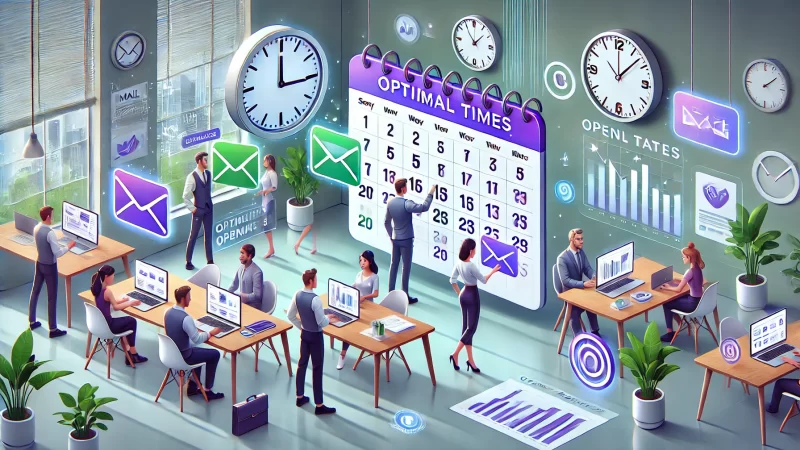
The timing and frequency of your email campaigns significantly influence their success. Sending emails at the right moment and with the right cadence helps maintain subscriber interest without overwhelming their inboxes.
Determining The Optimal Send Times For Your Audience
Finding the best time to send emails involves understanding your audience’s habits. I recommend experimenting with different send times to identify when your subscribers are most likely to open and engage with your messages.
Start with research. Studies often suggest mid-morning on weekdays as a general benchmark, but every audience is unique. Use analytics to track open rates and adjust based on real data.
Consider time zones. If your audience spans multiple regions, segmenting by location can help ensure emails arrive at a convenient time for everyone. I advise scheduling emails to accommodate different time zones.
Behavior-based triggers can also optimize timing. Sending emails based on actions, like abandoned carts or recent downloads, ensures messages are timely and relevant. This approach can boost engagement significantly.
Lastly, monitor trends. Audience habits may shift over time. Regularly reviewing performance metrics ensures you stay aligned with their preferences and continue sending emails at the most effective times.
How Often Should You Email Your Subscribers?
Determining how often to email your subscribers requires finding a balance. Too few emails risk losing engagement, while too many can lead to unsubscribes. I suggest starting with a moderate frequency and adjusting as needed.
Consider your content. If you have valuable updates or offers, weekly emails may work. For less frequent updates, biweekly or monthly schedules may be more appropriate. Quality always outweighs quantity.
Segment your audience. Not all subscribers need the same frequency. Tailor your schedule to each segment’s preferences or behavior. I’ve seen this approach reduce unsubscribe rates and improve satisfaction.
Watch for engagement signals. High open and click-through rates indicate your frequency is on track, while drops in these metrics suggest you may need to adjust. Stay flexible and responsive to feedback.
Provide options. Allow subscribers to set their email preferences, such as choosing weekly updates or opting for less frequent communications. This personal touch can boost trust and retention.
Monitoring Frequency To Avoid Subscriber Fatigue
Subscriber fatigue happens when recipients feel overwhelmed by your emails. Monitoring frequency and making adjustments based on engagement is key to maintaining long-term relationships.
Keep an eye on unsubscribes and spam complaints. A sudden increase in these metrics can indicate you’re sending too often. I advise scaling back if you notice these signs.
Review engagement rates regularly. Declining open and click-through rates may suggest your audience is losing interest. Experiment with lower frequencies to see if it improves results.
Offer re-engagement campaigns for inactive subscribers. Send a friendly message asking if they’d like to continue receiving your emails. This shows you value their preferences and respect their time.
Focus on content quality. Delivering valuable, relevant emails reduces the risk of fatigue, even if you send frequently. I recommend ensuring each email serves a clear purpose and aligns with subscriber interests.
Choosing The Right Email Marketing Tools
Selecting the right email marketing tools can transform your campaigns, making them more efficient and impactful. I believe the right tool saves time, simplifies processes, and helps you connect better with your audience.
Comparison Of Top Email Marketing Platforms
Different email marketing platforms cater to various needs, from beginners to advanced marketers. Let’s explore a few popular options to help you choose the one that fits your goals and budget.
Mailmunch is a user-friendly platform great for beginners. It offers free plans, simple automation, and intuitive design tools. I recommend it if you’re starting out and need an affordable, easy-to-use solution.
HubSpot is ideal for businesses seeking more advanced features. Its CRM integration, detailed analytics, and scalable options make it a top choice for growing companies aiming to streamline marketing and sales efforts.
Klaviyo shines for e-commerce brands. Its seamless integration with Shopify and rich data insights help personalize campaigns effectively. If you’re in retail, I suggest considering Klaviyo for boosting sales and engagement.
ConvertKit focuses on creators like bloggers and influencers. Its simplicity and tailored tools for audience-building make it perfect for those wanting to monetize their content and connect with followers personally.
Features To Look For In Email Campaign Software
When evaluating email marketing software, certain features stand out as must-haves. These capabilities make your campaigns efficient, effective, and easy to manage.
Automation capabilities are crucial. I recommend choosing tools that let you schedule emails, trigger workflows, and send reminders effortlessly. Automation saves time and ensures timely communication with your audience.
Look for robust analytics. Tools that track open rates, click-throughs, and conversions help measure performance. This insight lets you fine-tune strategies, focusing on what works best for your campaigns.
Ease of use is essential. Platforms with drag-and-drop editors, pre-designed templates, and simple interfaces are great for creating polished emails without technical expertise. This feature is especially helpful for small teams.
Integration options add value. I advise checking whether the platform connects seamlessly with CRM systems, social media, or e-commerce tools. Integration keeps your marketing ecosystem connected and efficient.
Why Automation Is Crucial For Campaign Success
Automation is a game-changer in email marketing, helping you stay consistent while saving time. I recommend prioritizing automation features when choosing tools for your campaigns.
With automation, you can nurture leads effortlessly. For instance, welcome emails sent automatically to new subscribers create a positive first impression and build trust. It’s like setting the tone without lifting a finger.
Trigger-based emails make your campaigns timely. Actions like abandoned carts or downloads can trigger specific emails, targeting customers when they’re most likely to convert. This precision boosts engagement and sales.
Automation ensures consistency. Scheduled campaigns keep your audience engaged regularly without requiring constant attention. I’ve seen brands thrive by staying top-of-mind through well-timed automated messages.
You can also personalize at scale. Platforms use data to tailor automated emails, making them feel personal even when sent to thousands. This creates stronger connections and improves overall campaign performance.
Testing And Optimizing Your Email Campaigns
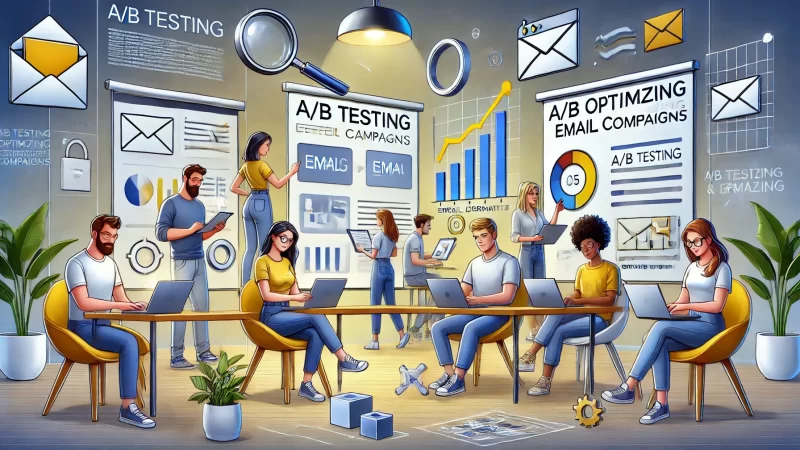
Testing and optimization are vital for creating high-performing email campaigns. I recommend treating every campaign as a learning opportunity to refine your strategies and achieve better results over time.
A/B Testing To Improve Performance
A/B testing is one of the most effective ways to optimize your campaigns. I suggest testing elements like subject lines, CTAs, and layouts to understand what resonates with your audience.
Start with a single variable. Testing one change at a time, such as two different subject lines, ensures clear results. This focused approach helps identify what works without confusion.
Track results consistently. Metrics like open rates and clicks reveal how each variation performs. I recommend analyzing the data to identify trends and apply the winning strategy in future campaigns.
Incorporate audience preferences. Testing different email lengths or tones can show what your subscribers prefer. I believe tailoring your content based on these insights creates more meaningful connections.
Run tests regularly. Campaigns evolve, and so do audience behaviors. Frequent testing keeps your emails fresh and aligned with subscriber expectations, leading to consistent improvement.
How To Analyze Key Metrics For Email Campaigns
Analyzing metrics helps you understand your email campaigns’ impact. I advise focusing on key performance indicators (KPIs) that align with your goals to get actionable insights.
Open rates indicate how appealing your subject lines are. If rates are low, I suggest experimenting with more engaging or personalized subject lines to draw in readers.
Click-through rates show how compelling your content is. Tracking which links get clicks reveals what your audience finds valuable, helping you refine CTAs and focus on popular topics.
Conversion rates highlight the success of your email’s goal. Whether it’s purchases or sign-ups, I believe optimizing landing pages and aligning email content with CTAs can improve this metric.
Monitor unsubscribes too. A spike can signal issues like irrelevant content or over-emailing. Understanding these patterns ensures you adjust strategies to retain your audience’s trust and interest.
Adjusting Your Strategy Based On Analytics
Analytics offer the insights needed to fine-tune your email marketing efforts. I recommend using data as a guide to make informed decisions and continuously improve your campaigns.
Identify weak points. If open rates are low, rework subject lines or optimize send times. Small adjustments in these areas often have a big impact on engagement.
Refine segmentation based on behavior. Analyzing which segments respond best to specific content lets you deliver more personalized, effective emails. This targeted approach builds stronger connections.
Experiment with content. Metrics can highlight which topics or formats perform well. I suggest using this information to explore new ideas while maintaining audience interest.
Track long-term trends. Comparing results across multiple campaigns provides valuable insights into what consistently works. This big-picture perspective helps guide your email marketing strategy moving forward.
Ensuring Compliance With Email Marketing Laws
Compliance with email marketing laws is essential to building trust and avoiding penalties. I recommend understanding key regulations and implementing best practices to protect your brand while delivering meaningful content to your audience.
Overview Of GDPR And CAN-SPAM Regulations
GDPR and CAN-SPAM are critical frameworks governing email marketing practices. Understanding their requirements ensures your campaigns remain lawful and respectful of your audience’s privacy.
The GDPR applies to businesses targeting individuals in the EU. It requires obtaining clear, explicit consent before sending marketing emails. I suggest being transparent about why you’re collecting data and how you’ll use it.
The CAN-SPAM Act governs email marketing in the U.S. It mandates that commercial emails include accurate sender information, clear subject lines, and an easy way to opt out. Ignoring these rules could lead to hefty fines.
Both regulations emphasize user rights. GDPR, for instance, allows users to access, update, or delete their data. Meanwhile, CAN-SPAM protects recipients from deceptive practices. Respecting these rights builds trust and credibility.
Keep records of consent and preferences. This documentation can help in case of audits or disputes. I advise using email marketing platforms with compliance tools to streamline the process and reduce risks.
How To Add Unsubscribe Links Correctly
Including an unsubscribe link is not just a legal requirement—it also demonstrates respect for your audience. I recommend making this process simple and transparent to maintain goodwill, even when someone decides to opt out.
Unsubscribe links should be easy to locate, typically at the bottom of the email. Hiding them frustrates users and could lead to complaints. A clear, visible link shows you value their choice.
The process should be straightforward. One-click unsubscribes are ideal. Avoid asking for unnecessary details or requiring multiple steps, as this can deter users from completing their request.
Acknowledge the opt-out immediately. Sending a confirmation email reassures the user that their request has been processed. I suggest phrasing this message politely to leave a positive impression.
Use the opportunity to gather feedback. Ask why they’re unsubscribing in a non-intrusive way. This insight can help improve future campaigns and address common concerns among your audience.
Tips To Keep Your Email List Compliant
Maintaining compliance with email marketing laws requires proactive management of your subscriber list. I believe it’s about balancing legal requirements with a commitment to respecting your audience.
Regularly clean your list by removing inactive or invalid addresses. This keeps your database accurate and improves deliverability rates. I suggest doing this quarterly to avoid sending emails to disengaged users.
Always use double opt-in for new subscribers. This method ensures they genuinely want to join your list, protecting you from accidental or fraudulent sign-ups. It’s a small step that has big compliance benefits.
Provide clear privacy policies. Let subscribers know how you’ll use their data. I recommend linking to your privacy policy in sign-up forms and emails for transparency and trust-building.
Train your team on compliance best practices. Everyone involved in your email marketing should understand GDPR, CAN-SPAM, and other relevant laws. Knowledgeable teams help avoid accidental breaches.
Analyzing And Improving Campaign Performance
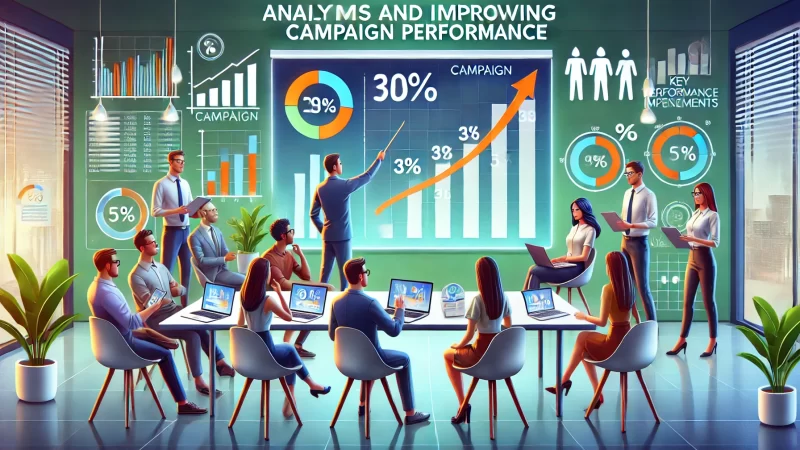
Analyzing email marketing performance helps you identify areas for improvement and optimize future campaigns. I recommend leveraging data and tools to make informed decisions that consistently enhance your results.
Tools To Track Email Marketing Metrics
The right tools make tracking email performance simple and effective. I suggest choosing platforms that provide comprehensive insights into subscriber behavior and campaign outcomes.
Google Analytics tracks user behavior beyond the email. Linking your emails to specific landing pages reveals how recipients interact with your site, providing deeper insights into conversions and engagement.
Email marketing platforms like Mailchimp or Klaviyo offer built-in analytics. They provide detailed reports on open rates, click-throughs, and more. These insights guide adjustments to improve results.
Heatmap tools, such as Hotjar, show where users click within your emails. This data helps refine design and CTA placement to maximize engagement and conversions.
Automation platforms like HubSpot combine analytics with CRM integration. I recommend this option for businesses seeking a unified view of email performance and broader marketing activities.
Key Performance Indicators For Campaign Success
Tracking the right metrics is essential to measuring success. I believe focusing on these KPIs helps you understand what’s working and where to improve in your email marketing campaigns.
Open rates reveal how effectively your subject lines capture attention. Low rates might indicate the need for more engaging or personalized headlines to pique interest.
Click-through rates measure engagement with your content. High rates suggest your message resonates, while low ones highlight the need for stronger CTAs or more relevant content.
Conversion rates track specific actions, such as purchases or sign-ups. Aligning email content with the desired outcome can improve this metric and drive better campaign ROI.
Bounce rates indicate delivery issues. High bounce rates suggest problems with your subscriber list quality. I advise removing invalid addresses to enhance deliverability and maintain sender reputation.
What To Do When Campaigns Underperform
Underperforming campaigns are opportunities to learn and grow. I recommend analyzing the data, identifying gaps, and experimenting with new strategies to turn challenges into successes.
Start with the basics. Review your subject lines, content, and CTAs. Sometimes, small tweaks like more engaging copy or a clearer action step can significantly improve results.
Survey your audience for feedback. Understanding what they want helps tailor your emails to their preferences. I suggest asking about content types, frequency, and formats to align your campaigns with their needs.
Test new approaches. Experiment with different email formats, designs, or offers to see what resonates. A/B testing provides valuable insights to refine your strategy over time.
Stay consistent and patient. Results often improve gradually as you implement changes and learn what works. I believe persistence and a willingness to adapt are key to overcoming challenges in email marketing.
Advanced Strategies For Higher Conversion Rates
Boosting email conversion rates requires adopting advanced strategies that engage subscribers and encourage action. I suggest exploring techniques like automation, cross-channel integration, and upselling to optimize performance and maximize campaign impact.
How To Leverage Email Automation Workflows
Email automation workflows streamline communication, ensuring timely and relevant messages reach your audience. I believe this approach saves time while delivering highly personalized experiences that drive engagement and conversions.
Start with welcome workflows for new subscribers. These automated sequences introduce your brand and highlight value, creating a strong first impression. A well-crafted welcome series can significantly improve engagement and build trust.
Behavior-based workflows take personalization to the next level. Trigger emails based on actions like abandoned carts, recent purchases, or website visits. These timely messages align with user interests, increasing the likelihood of conversion.
Re-engagement workflows help reconnect with inactive subscribers. A friendly reminder about benefits or an exclusive offer can rekindle interest. I recommend testing different approaches to find what motivates your audience to re-engage.
Use analytics to optimize workflows. Monitor open rates, clicks, and conversions to refine sequences over time. Adjusting based on performance data ensures your workflows remain effective and aligned with subscriber preferences.
Integrating Email Marketing With Social Media
Combining email marketing with social media creates a cohesive strategy that amplifies your message and extends reach. I suggest leveraging both channels to engage subscribers and foster deeper connections.
Promote social media through emails. Include links to your profiles, encouraging subscribers to follow and engage with your brand across platforms. This strengthens relationships and increases visibility.
Use social media insights to inform email content. Analyze what resonates with followers and adapt your email campaigns accordingly. This alignment keeps your messaging consistent and appealing.
Run cross-channel campaigns. For example, announce a social media giveaway through email or share exclusive email content on social platforms. I’ve seen this strategy boost engagement across both channels.
Encourage social sharing in emails. Adding share buttons or asking readers to spread the word extends your email’s reach. This creates opportunities to attract new subscribers and grow your audience organically.
Examples Of Successful Upselling Through Email
Upselling emails offer additional value by suggesting higher-tier products or complementary items. I recommend using this approach to maximize revenue while enhancing the customer experience.
One example is product recommendations. After a purchase, send an email highlighting related items or upgrades. I’ve found this works especially well when the suggestions are tailored to the buyer’s interests.
Exclusive offers can drive upsells. A message like “Upgrade to Premium and Save 20%” creates urgency and highlights value, making it easier for customers to consider the added benefits.
Bundle deals also work wonders. Show how purchasing multiple products together offers better value. I suggest showcasing how the items complement each other to increase appeal and drive conversions.
Highlight testimonials in upselling emails. Sharing real stories from satisfied customers helps build trust and demonstrates the value of your offer. This social proof can be the nudge needed to inspire action.
Building Long-Term Relationships With Subscribers

Building lasting relationships with your email subscribers ensures loyalty and sustained engagement. I recommend focusing on consistent communication, trust-building strategies, and follow-ups to create meaningful connections that drive long-term success.
How To Maintain Engagement With Consistent Content
Consistency in email content keeps subscribers engaged and looking forward to your messages. I believe delivering value regularly is the key to staying relevant and fostering loyalty.
Create a content calendar. Planning emails ahead of time ensures a steady flow of relevant, high-quality content. A mix of educational, promotional, and entertaining messages keeps the experience dynamic.
Segment your list to tailor content. Different subscriber groups may have varying interests. I recommend crafting messages that resonate with each segment for maximum impact.
Incorporate seasonal themes. Timely content, like holiday offers or industry trends, keeps emails fresh and engaging. It also shows you’re in tune with your audience’s current needs and interests.
Ask for feedback. Regularly survey your subscribers about their preferences. This not only informs your strategy but also makes them feel valued, strengthening the relationship over time.
Tips For Building Trust Through Email Campaigns
Trust is the foundation of any successful email marketing strategy. I suggest focusing on transparency, reliability, and delivering consistent value to earn and maintain your audience’s trust.
Be honest about your offerings. Overpromising can damage credibility. I’ve found that setting realistic expectations and delivering on them keeps subscribers satisfied and engaged.
Provide value in every email. Whether it’s tips, discounts, or resources, ensure your content is useful. This reinforces the idea that subscribing to your list is worth their time.
Avoid over-emailing. Sending too many messages can lead to fatigue and unsubscribes. I recommend finding the right balance by monitoring engagement and respecting subscriber preferences.
Show the human side of your brand. Share behind-the-scenes stories or team introductions. This personal touch builds authenticity and helps your audience connect with you on a deeper level.
How To Use Follow-Up Emails To Nurture Leads
Follow-up emails are an essential tool for nurturing leads and guiding them through the customer journey. I believe timely, personalized follow-ups can turn prospects into loyal customers.
Start with a thank-you email. After an initial interaction, such as a download or inquiry, send a message expressing appreciation. This small gesture sets a positive tone for future communication.
Provide additional value in follow-ups. Share resources, guides, or tips related to their interests. I suggest tailoring these emails to the lead’s behavior or preferences for greater impact.
Introduce your offerings gradually. Avoid overwhelming leads with sales pitches. Instead, focus on educating them about your products or services and how they address their needs.
Use urgency strategically. Limited-time offers or deadlines in follow-ups can encourage action without feeling pushy. This approach often drives conversions while respecting the recipient’s decision-making process.



